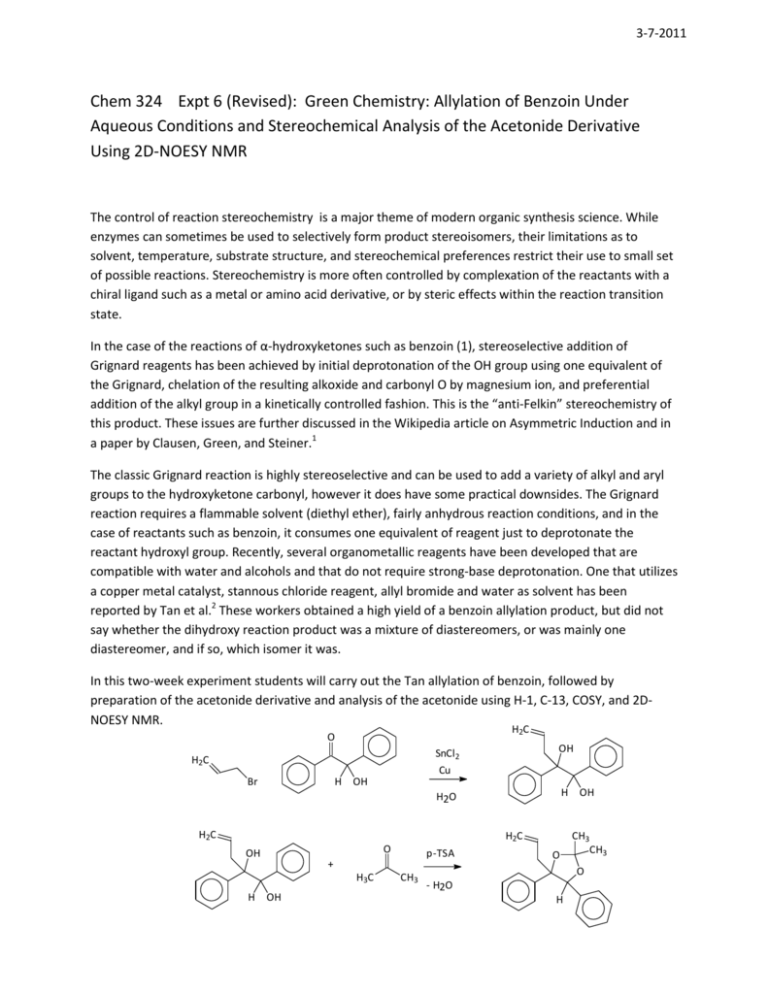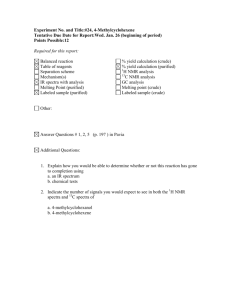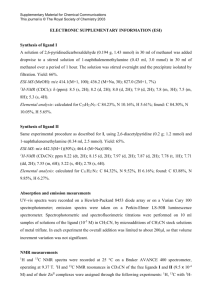Chem 324 Expt 6 (Revised): Green Chemistry: Allylation of Benzoin
advertisement

3-7-2011 Chem 324 Expt 6 (Revised): Green Chemistry: Allylation of Benzoin Under Aqueous Conditions and Stereochemical Analysis of the Acetonide Derivative Using 2D-NOESY NMR The control of reaction stereochemistry is a major theme of modern organic synthesis science. While enzymes can sometimes be used to selectively form product stereoisomers, their limitations as to solvent, temperature, substrate structure, and stereochemical preferences restrict their use to small set of possible reactions. Stereochemistry is more often controlled by complexation of the reactants with a chiral ligand such as a metal or amino acid derivative, or by steric effects within the reaction transition state. In the case of the reactions of α-hydroxyketones such as benzoin (1), stereoselective addition of Grignard reagents has been achieved by initial deprotonation of the OH group using one equivalent of the Grignard, chelation of the resulting alkoxide and carbonyl O by magnesium ion, and preferential addition of the alkyl group in a kinetically controlled fashion. This is the “anti-Felkin” stereochemistry of this product. These issues are further discussed in the Wikipedia article on Asymmetric Induction and in a paper by Clausen, Green, and Steiner.1 The classic Grignard reaction is highly stereoselective and can be used to add a variety of alkyl and aryl groups to the hydroxyketone carbonyl, however it does have some practical downsides. The Grignard reaction requires a flammable solvent (diethyl ether), fairly anhydrous reaction conditions, and in the case of reactants such as benzoin, it consumes one equivalent of reagent just to deprotonate the reactant hydroxyl group. Recently, several organometallic reagents have been developed that are compatible with water and alcohols and that do not require strong-base deprotonation. One that utilizes a copper metal catalyst, stannous chloride reagent, allyl bromide and water as solvent has been reported by Tan et al.2 These workers obtained a high yield of a benzoin allylation product, but did not say whether the dihydroxy reaction product was a mixture of diastereomers, or was mainly one diastereomer, and if so, which isomer it was. In this two-week experiment students will carry out the Tan allylation of benzoin, followed by preparation of the acetonide derivative and analysis of the acetonide using H-1, C-13, COSY, and 2DNOESY NMR. H2C O H2C Br H SnCl2 Cu OH H2O H OH H2C H2C O OH + H3C H p-TSA OH CH3 O OH CH3 CH3 O - H2O H Procedure Alllylation. According to Tan:2 “Typical procedures for the allylation are as follows: To a mixture of carbonyl compound (10 mmol) and allyl halide (15 mmol) in water (20 ml), copper powder (20 mmol) and SnCl2 (20 mmol) were added in one portion. The mixture was vigorously stirred at room temperature for approximately 3 h. The mixture was extracted with ether (3×30 ml). The combined organic layers were dried over anhydrous MgSO4 and were filtered and evaporated. The residue, in most cases, afforded the corresponding homoallylic alcohols of sufficient purity as judged by TLC and 1H NMR without the need for further purification.” The reaction, extraction, and solvent evaporation should be carried out in the fume hood to minimize exposure to the lachrymatory allyl bromide. Allyl bromide should be dispensed by syringe by the TA. Tan recommends an 8-h reaction time at RT; reactions will be started in lab, then after 8 h stored in the freezer until workup later in the week. The ether extraction should be carried out in situ in portions with vigorous magnetic stirring, followed by removal of the ether upper phases using a 10-mL pipet. The combined ethereal layer should be back-extracted with several water washes. The crude product can be compared to benzoin by TLC using a 9:1 CH2Cl2:methanol solvent system on silica plates. Obtain H-1 and C-13 NMR spectra of the product in CDCl3. In practice, there is a significant unwanted side reaction of aqueous hydrolysis of allyl bromide to allyl alcohol (bp 97°C), which may be seen in the NMR spectra of the crude product. This can be removed by several water extractions, or under vacuum at RT. Heating of the crude product above RT is not recommended due to the reactive nature of the product’s tertiary benzylic homoallyic OH. Also, the occurrence of the side reaction suggests a modification of the above procedure to use a 10-15% molar excess of allyl bromide for complete conversion of benzoin to product. Acetonide formation. For synthesis of the acetonide, half of the crude diol should be dissolved in 10-20 mL of reagent grade acetone, plus about 5 mg of p-toluenesulfonic acid (p-TSA). After a day or two at RT, the reaction is extracted with diethyl ether or dichloromethane, washed with dilute aqueous bicarbonate, dried with anhydrous magnesium sulfate, and the solvent removed by rotary evaporation. Obtain H-1 and C-13 of the acetonide product. COSY, and gNOESY spectra will be provided. Use HyperChem molecular mechanics MM+ method to optimize each of two possible acetonide structures. Please make both your structure with the same configuration at the CH carbon, which will facilitate comparisons between the isomers. Use the Conformational Search function under Compute menu to make sure you have the most stable conformation of each stereoisomer. Then use these structures to interpret cross peaks in the 2D NOESY spectrum. 2D-NOESY NMR This is a type of H-H homonuclear correlation NMR spectroscopy in which energy transfer occurs between H’s through space. Such interactions depend strongly on the separation distance between H’s, going as a function of r-6. The handout provided of the 2D NOESY spectrum of strychnine can be used as an example of structure elucidation with this method. It is helpful to open a strychnine structure handy to find closely situated H’s. (Bing “strychnine pdb file” and save the file as a .mol then open with HyperChem.) Another source that contains an interactive exercise in interpretation of 2D-H,H NOESY spectra can be accessed on the web at the following URL: http://www.chem.queensu.ca/FACILITIES/NMR/nmr/webcourse/ This website also has several other interactive spectra. Report Include Introduction, Experimental Section, Results, Discussion, and References sections. In the Introduction summarize some of the points made in this handout in your own words. In the Experimental Section include 3 paragraphs: general methods, diol synthesis, acetonide synthesis. Use the style of writing illustrated in the Journal of Organic Chemistry paper by Mitchell et al.,3 that is, including only enough information that a knowledgeable organic chemist could reproduce the results. The experimental section of a chemistry paper is aimed at practitioners, not neophytes. Include the absolute(g) and relative (%) yields. Indicate the file names of all spectra used in the report. In the Results section, divide it into diol and acetonide sections, show the formulas of reactants and products including stereochemistry, briefly re-tell the experimental process and outcome, show large graphics of the NMR spectra with graphical correlations of peaks and corresponding atom assignments, and a paragraph or two explaining the NMR spectra and assignments. Pay close attention to the stereochemistry of the acetonide product, and tell exactly which cross-peaks in the NOESY reveal the stereochemistry of the acetonide product. In the Discussion section, write out a reasonable stepwise mechanisms for the allylation reaction and the acetonide formation using curved arrow notation. Also include a diagram or structural formula for the transition state of the allyl addition leading to the observed diol product, and of course provide a written commentary on same. Hand in hard copies of the report, and send electronic copies of the report and .hin files used, to jwkeller@alaska.edu. References (1) (2) (3) Clausen, T. P.; Green, T. K.; Steiner, B. J. Chem. Educ. 2008, 85, 692. Tan, X.-H.; Shen, B.; Liu, L.; Guo, Q.-X. Tetrahedron Lett. 2002, 43, 9373. Mitchell, R. H.; Carruthers, R. J.; Mazuch, L.; Dingle, T. W. J. Am. Chem. Soc. 1982, 104, 2544.




